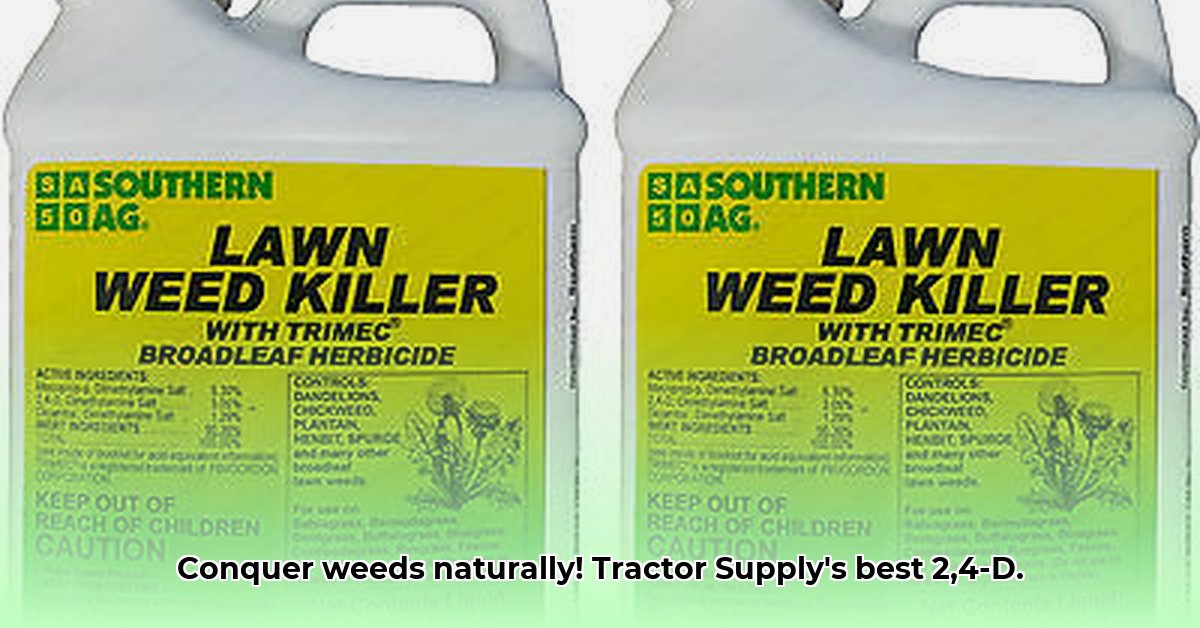
2,4-D Weed Killer Tractor Supply: Your Smart Guide to Weed Control
Controlling weeds effectively is crucial for healthy crops and beautiful gardens. This guide focuses on 2,4-D weed killers available at Tractor Supply, emphasizing responsible and environmentally conscious choices. We'll explore product selection, safe application, and sustainable alternatives. For maintaining your lawn after weed control, check out our guide on Tractor Supply lawn mowers.
Understanding 2,4-D: What It Is and How It Works
2,4-D (2,4-Dichlorophenoxyacetic acid) is a common herbicide targeting broadleaf weeds (those with wider leaves than grasses). It disrupts weed growth hormones, leading to rapid growth and eventual death. Tractor Supply offers various 2,4-D formulations, but responsible use is paramount. Effectiveness doesn't equate to safety or sustainability.
Choosing the Right 2,4-D at Tractor Supply: Key Considerations
Tractor Supply offers a variety of 2,4-D products. To make an informed choice, consider these factors:
Concentration: Higher concentrations are more potent but require careful handling. Lower concentrations are gentler but may need more frequent applications. Always check the label for the specific concentration.
Formulation: Choose from liquid concentrates (versatile for spot-treating or larger areas), ready-to-use sprays (convenient for smaller areas), or granules (suitable for broadcast applications but requiring soil incorporation). Select the formulation best suited to your needs and application method.
Target Weeds: The product label lists the weeds effectively controlled by that specific formulation. Choosing the right product for your target weeds maximizes effectiveness and minimizes environmental impact. Don't waste resources on an ineffective herbicide!
Applying 2,4-D Safely and Effectively: A Step-by-Step Guide
Safe and effective application is vital. Following these steps minimizes risk to humans and the environment:
Read the Label: Always read and understand the label instructions thoroughly before applying any herbicide. This includes application rates, safety precautions, and disposal procedures. Ignoring this is irresponsible and potentially hazardous.
Prepare Equipment: Inspect and calibrate sprayers or spreaders. Always wear appropriate protective gear: gloves, eye protection, long sleeves, and potentially a mask depending on wind conditions and formulation.
Timing is Key: Apply 2,4-D in the early morning or late evening when winds are calm to minimize drift and evaporation. Avoid application during hot, sunny days or before anticipated rainfall. Proper timing enhances effectiveness and reduces the environmental footprint.
Follow Application Rates: Never exceed the recommended application rate on the label. More isn't better; it increases the risk of harming non-target plants and polluting water sources. Accuracy is paramount.
Spot Treat When Possible: Treat only the weeds, not the entire area. Spot treating minimizes herbicide use and protects desirable plants. This is a more sustainable approach.
Proper Disposal: Dispose of any leftover herbicide and packaging according to label instructions. Improper disposal pollutes water sources and damages the environment.
Sustainable Weed Control: Exploring Alternatives and IPM
While 2,4-D can be effective, consider more environmentally friendly approaches. Integrated Pest Management (IPM) combines various methods to reduce chemical herbicide reliance. Consider these alternatives:
- Weed Prevention: Mulching, crop rotation, and proper soil preparation reduce weed growth, limiting the need for herbicides.
- Mechanical Control: Hand weeding, hoeing, and tilling are labor-intensive but effective for small areas and require no chemicals.
- Biological Control: Introducing natural weed predators can be effective but requires specialized knowledge and understanding.
How to Choose the Best Bioherbicides for Sustainable Farming
Sustainable agriculture demands responsible weed control. Bioherbicides offer an eco-friendly alternative to synthetic herbicides. Their selection requires careful consideration:
Choosing Bioherbicides: A Step-by-Step Guide
Identify Your Weeds: Accurate identification of weeds is vital for selecting an effective bioherbicide. Consult local resources for help with identification.
Crop Compatibility: Ensure the bioherbicide is compatible with your crops. Check for any potential negative interactions.
Efficacy: Assess the bioherbicide's documented efficacy against your target weeds under your specific conditions.
Formulation: Consider the formulation (spray, granule, etc.) and its suitability for your application methods.
Environmental Impact: Choose biodegradable options with minimal environmental impact. Look for certifications and independent assessments.
Cost-Effectiveness: Balance upfront cost with long-term environmental and economic benefits.
Regulations: Check local regulations for bioherbicide use and application guidelines.
Bioherbicide Advantages and Disadvantages:
| Advantage | Disadvantage |
|---|---|
| Environmentally friendly | Lower efficacy compared to synthetic herbicides |
| Reduced risk to non-target organisms | Higher cost in some cases |
| Biodegradable | Narrower weed control spectrum |
| Promotes biodiversity | Variable bioactive compound content |
| Potential for resistance management | Potential for formulation challenges |
Choosing the right weed control method requires careful consideration. Responsible use of 2,4-D or adoption of sustainable alternatives like bioherbicides helps protect both the environment and your crops.